Cigarette smoking is the leading preventable cause of death in the
Cigarette smoking has been well documented as a leading risk factor for many disorders, including cancers of the lung, colon, prostate, liver and ovaries.3-7 Optometrists now know that smoking affects eye and visual health as well. Not only is cigarette smoke an environmental source of eye irritation, but also chronic smoking can lead to ocular surface disease, including dry eye syndrome.8
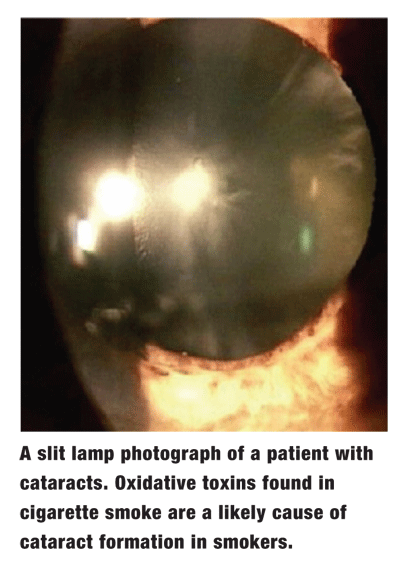 Additionally, smoking has been linked to increased rates of age-related macular degeneration (AMD), cataract formation, reduction in the central visual field, delayed response to treatment of episcleritis and scleritis, increased risk of Graves ophthalmopathy and worsening of Lebers optic atrophy.9-16 In fact, several published studies contend that smoking is the only modifiable risk factor for AMD.17,18
Additionally, smoking has been linked to increased rates of age-related macular degeneration (AMD), cataract formation, reduction in the central visual field, delayed response to treatment of episcleritis and scleritis, increased risk of Graves ophthalmopathy and worsening of Lebers optic atrophy.9-16 In fact, several published studies contend that smoking is the only modifiable risk factor for AMD.17,18
Making the Case
Many healthcare professionals, including dentists, nurses, pharmacists and pharmacy technicians, have taken steps to help patients quit smoking.19-27
Researchers have found that patients respond well to intervention, regardless of which type of healthcare professional recommends smoking cessation.28
In the editorial, Is it Any of Our Business if Our Patients Smoke?, published in Clinical and Experimental Optometry, David M. Cockburn, O.D., points out that by helping patients quit smoking, O.D.s can also help them reduce the risk of both eye and systemic problems.29
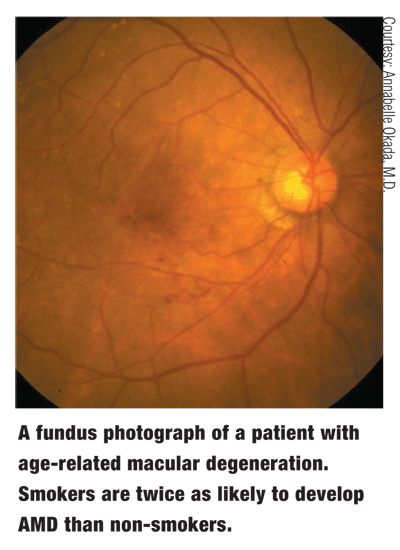 Mort Soroka, Ph.D., Director of the Center for Vision Care Policy at the State University of New York State College of Optometry, agrees. Dr. Soroka, who is also chair-elect of the American Public Health Associations Vision Care Section, suggests that optometrists should include demographic data and social and cultural habits, including smoking, in their patients case histories. As we know today, there are significant associations between smoking and a number of ocular conditions, including cataracts and macular degeneration, he says.30 As part of the healthcare team, optometric practitioners must delve into a wide range of activities that their patients are engaged in, because these will ultimately affect the care rendered and the visual health of the patient.30
Mort Soroka, Ph.D., Director of the Center for Vision Care Policy at the State University of New York State College of Optometry, agrees. Dr. Soroka, who is also chair-elect of the American Public Health Associations Vision Care Section, suggests that optometrists should include demographic data and social and cultural habits, including smoking, in their patients case histories. As we know today, there are significant associations between smoking and a number of ocular conditions, including cataracts and macular degeneration, he says.30 As part of the healthcare team, optometric practitioners must delve into a wide range of activities that their patients are engaged in, because these will ultimately affect the care rendered and the visual health of the patient.30
Optometrists also need to inform patients about the relationship between smoking and eye disease. Consider: A recent study from the
Loss of sight was rated as the most frightening health effect from smoking; even worse than lung cancer, heart disease or stroke.31 The information linking smoking and vision loss may motivate teens to stop smoking, as 90% reported that they would give up smoking at the first signs of blindness.31 Eye care practitioners, particularly primary care optometrists, should consider asking their adolescent patients whether they smoke and provide advice on quitting to those who do, the authors concluded.31
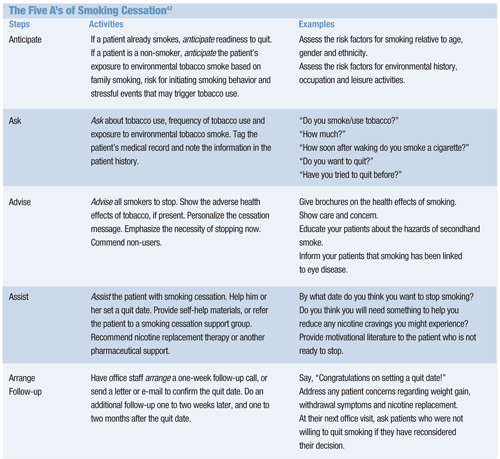
Recommended Steps for Cessation
Daniel Bintz, O.D., of
Dr. Bintz says that many of his patients are elderly and suffer from AMD. He directly witnesses how difficult and frustrating macular degeneration can be for individuals to cope with. So, Dr. Bintz has taken personal interest in advocating smoking cessation.
If you want to help patients permanently quit smoking, consider a five-step approach, or the five As of smoking cessation intervention (see The Five As of Smoking Cessation). Many of the steps involve minimal time and effort on your part.
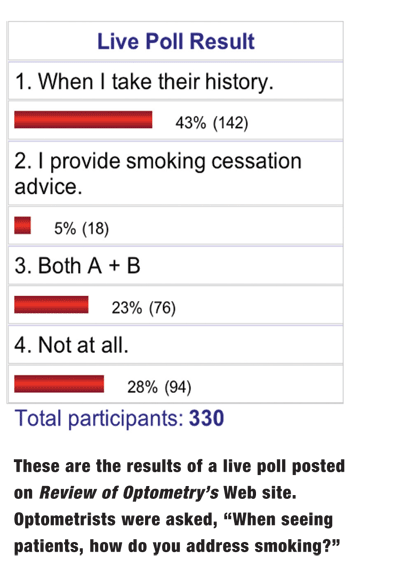 A recent analysis of 39 research studies found that intensive interventions typically have a profound effect on individuals.33 Thus, the more you and your staff do, the more likely your patients are to quit smoking entirely.
A recent analysis of 39 research studies found that intensive interventions typically have a profound effect on individuals.33 Thus, the more you and your staff do, the more likely your patients are to quit smoking entirely.
You might wish to either perform all of the suggested steps in your practice, or refer patients to local smoking cessation programs and community-based resources.
Many states have used money from tobacco settlements to provide smoking cessation education and support programs. Check with your local health department to learn about available resources in your particular area.
Prescription for Help
The FDA has approved nicotine replacement therapy, Zyban (bupropion, GlaxoSmithKline) and Chantix (varenicline, Pfizer) as first-line treatments for nicotine dependence. The Agency for Healthcare Research and Quality recommends clonidine and nortriptyline as second-line treatments.34
Nicotine replacement therapy has been found to be more effective in helping patients stop smoking than just quitting cold turkey.28,35 Nicotine gum, lozenges and patches are readily available over-the-counter, and can be recommended as a safe choice for your patients. Nicotine nasal spray and inhalers are also available by prescription. Nicotine spray pumps and inhalers rapidly deliver aerosolized nicotine to the patient through the nasal membranes. Nicotine spray is absorbed into the blood stream rapidly, which quells cravings more hastily than nicotine gum or patches.
Common side effects from nicotine replacement therapy include headache, nausea and dizziness. Nicotine patches can cause skin rashes and irritation, and nicotine nasal spray can cause sneezing, sore throat, runny nose and watery eyes.
Zyban. A review of 221 research articles found that Zyban is effective in smoking cessation. The medication is especially useful for treating patients who are
long-term smokers and may have cardiovascular disease, chronic obstructive pulmonary disease or depression. The evidence suggests that Zyban both reduces withdrawal symptoms and helps to mitigate weight gain.
Serious side effects of Zyban are rare. The major safety concern is risk of seizures, which is estimated at approximately 0.1%.36 The drug is contraindicated for any patient who has a diagnosed seizure disorder or a past history of seizures. Approximately 3% of patients using Zyban reported allergic reactions and minor side effects, such as dry mouth and sleep loss.36
Chantix. This drug was found to be three times more effective in long-term smoking cessation than simply quitting cold turkey. So far, clinical trials reported more participants quit successfully with Chantix than with Zyban.
Nausea is the primary side effect of Chantix. However, patients typically experience this symptom at mild to moderate levels, which tend to occur less frequently over time.37
A review of the drugs naloxone and naltrexone found that it was impossible to either confirm or deny their effectiveness regarding smoking cessation.38
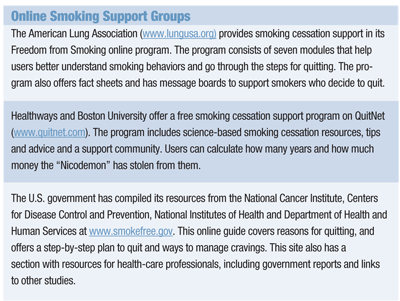
Alternative Therapies
Some patients prefer to incorporate complementary and alternative medicine (
According to the research data, the most effective intervention methods were yoga, relaxation, meditation and massage therapy.39 A more intensive, scientific review of nine controlled studies found that hypnotherapy did not produce greater success rates than any other therapies after six months.40
Online programs can also serve as helpful resources for patients who want to quit smoking. You can easily include links to this information on your offices Web site or in online newsletters. Also, you can list the various Web sites in a patient brochure, or simply write them on a prescription pad. (For examples, see Online Smoking Support Groups.)
The Next Steps
New warning labels on cigarette packaging may soon help optometrists educate their patients about smoking. Members of the American Public Health Associations (APHA) Vision Care Section hope to persuade the federal government to include a warning on cigarette packets to indicate that smoking may cause vision loss and blindness. Dr. Bintz is currently outlining and writing a public health policy proposal.
As clinicians, were familiar with the ocular and systemic risks of tobacco use, but there is a disconnect when it comes to educating the public, says Greg Hom, O.D., M.P.H., of San Diego, Chair of the APHA Vision Care Section.41 He adds, We hope that the proposed policy will enhance efforts to let people know that tobacco use can lead to eye disease and disability.41
We all provide eye care for people who smoke cigarettes every day. The next time you have a smoker in your exam chair, take the first step: Ask if your patient would like to quit. You might help to save someones vision by preventing a smoking-related disabilityand possibly prevent a smoking-related death.
Dr. Hoppe is the Founding Dean of the Western University of Health Sciences College of Optometry in
1. CDC. Annual smoking-attributable mortality, years of potential life lost, and economic costsUnited States, 1995-1999. MMWR 2002;51:300-3.
2. Porter S, Jackson K, Trosclair A, et al. Office on Smoking and Health, National Center for Chronic Disease Prevention and Health Promotion, CDC. Prevalence of Current Cigarette Smoking Among Adults and Changes in Prevalence of Current and Some Day SmokingUnited States, 19962001. MMWR 2003 Apr;52(14):303-7.
3. Rachet B, Siemiatycky J, Abrahamoqicz M, et al. A flexible model approach to estimating the component effects of smoking behavior on lung cancer. J Clin Epidemiol 2004 Oct;57(10):1076-85.
4. Luchtenborg M, Weijenberg MP, Kampman E, et al. Cigarette smoking and colorectal cancer: APC mutations, hMLH1 expression, and GSTM1 and GSTT1 poly morphisms. Am J Epidemiol 2005 May;161(9):806-15.
5. Oefelein MB, Resnick MI. Assocation of tobacco use with hormone refractory disease and survival of patients with prostate cancer. J Urol 2004 Jun;171(6 pt 1):2281-4.
6. Chen ZM, Liu BQ, Boreham J, et al. Smoking and liver cancer in
7. Terry PD, Miller AB, Jones JG, et al. Cigarette smoking and the risk of invasive epithelial ovarian cancer in a prospective cohort study. Eur J Cancer 2003 May;39(8):1157-64.
8. Satici A, Bitiren M, Ozardali I, et al. The effects of chronic smoking on the ocular surface and tear characteristics: a clinical, histological and biochemical study. Acta Ophthalmol Scand 2004 Dec;81(6):583-7.
9. Clemons TE, Milton RC, Klein R, et al. Risk factors for the incidence of advanced age-related macular degeneration in the Age-Related Eye Disease Study (AREDS) AREDS report no. 19. Ophthalmology 2005 Apr;112(4):533-9.
10. Tomany SC, Wang JJ, vanLeeuwen R, et al. Risk factors for incident age-related macular degeneration. Ophthalmolgy 2004 Jul;111:1280-7.
11. Klein AP, Duggal P, Lee KE, et al. Polygenic effects and cigarette smoking account for a portion of the familial aggregation of nuclear sclerosis. Am J Epidemiol 2005 Apr 15;161(8):707-13.
12. Krishnaiah S, Vilas K, Shamanna BR, et al. Smoking and its association with cataract: results of the Andhra Pradesh eye disease study from
13. Akarsu C, Yazici B, Taner P, et al. Effects of moderate smoking on the central visual field. Acta Ophthalmol Scand 2004 Aug;82(4):432-5.
14. Boonman ZF, de Keizer RJ, Watson PG. Smoking delays the response to treatment in episcleritis and scleritis. Eye 2005 Sep;19(9):949-55.
15. Hegedius L, Brix TH, Vestergaard P. Relationship between cigarette smoking and
16. Sadun F, De Negri AM, Carelli V, et al. Ophthalmologic findings in a large pedigree of 11778/Haplogroup J Leber hereditary optic neuropathy. Am J Ophthlmol 2004 Feb;137(2):271-7.
17. Thornton J, Edwards R, Mitchell P, et al. Smoking and age-related macular degeneration: A review of association. Eye 2005 Sep;19(9):935-44.
18. Guymer RH, Chong EW. Modifiable risk factors for age-related macular degeneration. Med J Aust 2006 May;184(9):455-8.
19. Crews K, Taybos G. Role of dentists in tobacco cessation programs.
20. Simoyan OM, Badner VM, Freeman KD. Tobacco cessation services in dental offices. Are we doing all we can? NY State Dent J 2002 Aug-Sep;68(7):34-40.
21. Tomar SL. Dentistrys role in tobacco control. J Am Dent Assoc 2001 Nov;132 Suppl:30S-35S.
22. Youdan B, Queally B. Nurses role in promoting and supporting smoking cessation. Nurs Times 2005 Mar;101(10):26-7.
23. Zillich AJ, Aquilino ML, Farris KB. Knowledge and attitudes about smoking cessation among pharmacy technicians. J Am Pharm Assoc (
24. Sinclair HK, Bond CM, Stead LF. Community pharmacy personnel interventions for smoking cessation. Cochrane Database Syst Rev 2004;(1):CD003698.
25. Hudmon KS, Hemberger KK, Corelli RL, et al. The pharmacists role in smoking cessation counseling: perceptions of users of nonprescription nicotine replacement therapy. J Am Pharm Assoc (
26. Zillich AJ, Ryan M,
27. Williams DM, Newsom JF, Brock TP. An evaluation of smoking cessation-related activities by pharmacists. J Am Pharm Assoc (
28. Mojica WA, Suttorp MJ, Sherman SE, et al. Smoking-cessation interventions by type of provider: A meta-analysis. Am J Prev Med 2004 Jun;26(5):391-401.
29. Cockburn DM. Is it any of our business if our patients smoke? Clinical and Experimental Optometry 2005 Jan;88(1):2-4.
30. Sorka M. Personal Interview by Author. May 2007.
31. Moradi P, Thornton J, Edwards R, et al. Teenagers perceptions of blindness related to smoking: A novel message to a vulnerable population group. Br J Ophthalmol 2007 May;91(5):605-7. Epub 2007 Feb 6.
32. Bintz D. Personal Interview by Author. May 2007.
33. Lancaster T, Stead L. Physican advice for smoking cessation. Cochrane Database Syst Rev 2004 Oct (4):CD000165.
34. Schnoll RA, Lerman C. Current and emerging pharmacotherapies for treating tobacco dependence. Expert Opin Emerg Drugs 2006 Sep;11(3):429-44.
35. Silagy C, Lancaster T, Stead L, et al. Nicotine replacement therapy for smoking cessation. Cochrane Database Syst Rev 2004;(3):CD000146.
36. Richmond R, Zwar N. Review of bupropion for smoking cessation. Drug Alcohol Rev 2003 Jun;22(2):203-20.
37. Cahill K, Stead LF, Lancaster T. Nicotine receptor partial agonists for smoking cessation. Cochrane Database Syst Rev 2007 Jan24;(1):CD006103.
38. David S, Lancaster T, Stead LF, et al. Opioid antagonists for smoking cessation. Cochrane Database Syst Rev 2006 Oct;18(4):CD003086.
39. Sood A, Ebbert J, Sood R, et al. Complementary treatments for tobacco cessation: a survey. Nicotine Tob Res 2006 Dec;8(6):767-71.
40. Abbot NC, Stead LF,
41. Hom G. Personal Interview by Author. May 2007.
42. Hoppe E. A model curriculum for teaching optometry students about smoking cessation education. Optometric Education 1998 24(1):21-6.

